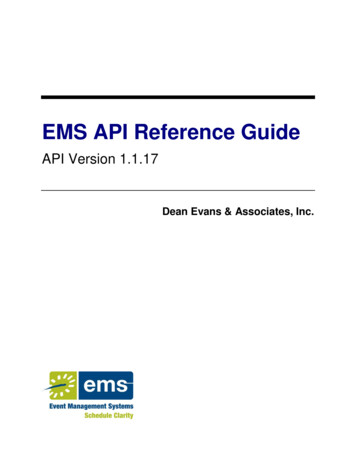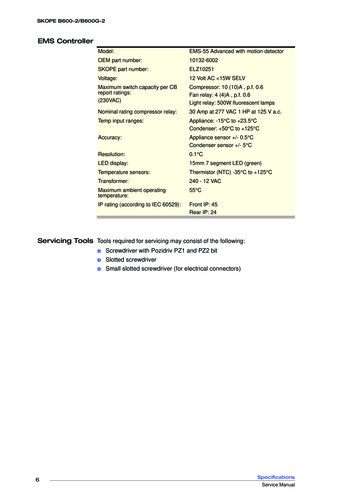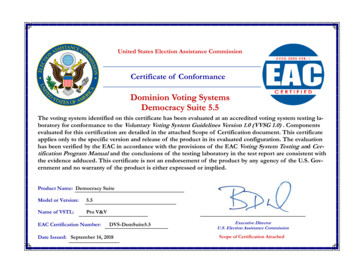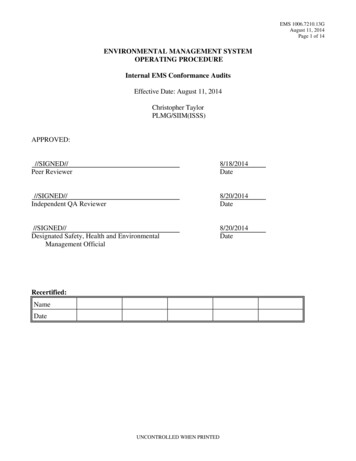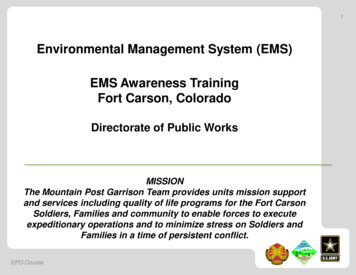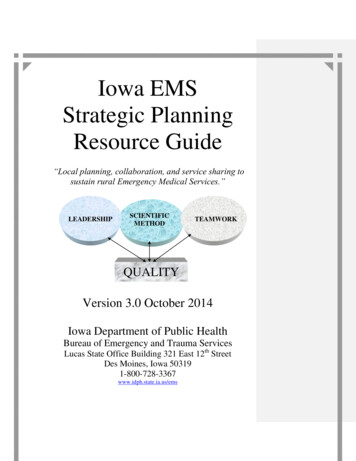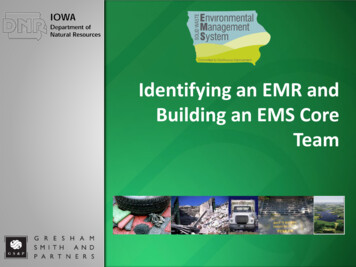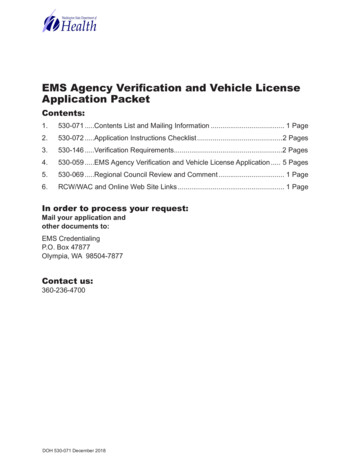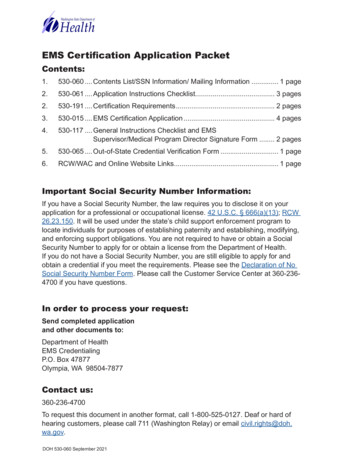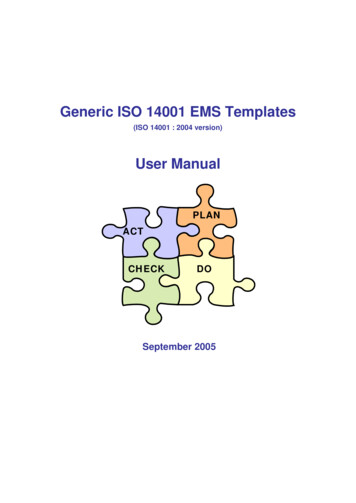
Transcription
2021ANNUALUPDATENHTSA OFFICE OF EMSThe Office of EMS is housed within theNational Highway Traffic Safety Administrationin the U.S. Department of TransportationU.S. Department of TransportationNational Highway Traffic Safety AdministrationADVANCINGEMS SYSTEMSSupporting the importance of developingEMS as a coordinated system of careEDUCATIONSupporting a nationwide systemsapproach to EMS educationRESEARCHAnalyzing data and measuringperformance to enable improvementsin EMS systemsWORKFORCESupporting efforts to strengthen andprepare the EMS workforce nationwideSAFETYProtecting the health and safety of EMSclinicians and their patientsEMS DATACollecting and sharing standardized EMSdata to support improvements in patientcare and EMS systemsPREPAREDNESSFostering collaboration to enhancereadiness for catastrophic incidents911 SYSTEMSProviding leadership and coordination tosupport and promote optimal 911 services
2021 Annual UpdateADVANCING EMS SYSTEMSDevelopment of EMS Quality Measures –EMS Compass engaged the EMS community anddesigned a process for the development, testingand evaluation of EMS performance measures.That work is now being continued through theNational EMS Quality Alliance (NEMSQA), a coalitionof EMS organizations created with support fromNHTSA to create, evaluate and publish EMS qualitymeasures. NEMSQA released revised EMS Compassmeasures in 2019 and continues to work on thedevelopment of new measures. Ten NEMSQAmeasures are aligned with the NEMSIS DataStandard for consistency in research anddocumentation. Find the NEMSQA measures andlearn how to get involved on the NEMSQA website.National Model EMS Clinical Guidelines Version3.0 – The NHTSA Office of EMS and HRSA EMSfor Children program supporting NASEMSO’sdevelopment of version 3 of the National ModelEMS Clinical Guidelines. These guidelines, based onthe latest evidence and professional consensus areused by state and local EMS systems as a referencefor developing their own EMS protocols. NASEMSOwill solicit public comment on draft guidelines in fall2021 and is targeting finalization of guidelines inearly 2022. More information about the guidelines,which were first developed in 2012 as a resource tobe used or adapted for use on a state, regional orlocal level to enhance prehospital patient care, canbe found on the NASEMSO website.State EMS Assessments – At the request of stateofficials, the NHTSA Office of EMS (OEMS) bringstogether teams of experts from around the countryto evaluate state EMS systems. Through in-persondiscussions with state and local EMS stakeholders,observations of systems and infrastructure, andreviews of state and local data, the team developsrecommendations to help the state’s EMS officeevaluate and improve its EMS system. Learn moreon ems.gov.Tribal EMS Collaboration – NHTSA OEMS iscollaborating with the Indian Health Service, EMSfor Children program and the University of NewMexico Center for Rural and Tribal EMS toimprove communication, access to resourcesand engagement with Tribal EMS clinicians andagencies across the country.PROMOTING EDUCATIONNational EMS Education Standards – Withsupport from the Health Resources and ServicesAdministration Maternal and Child Health Bureau’sEMS for Children Program and NHTSA Office ofEMS, the National Association of EMS Educatorsand RedFlash Group led a collaborative effort toupdate the National EMS Education Standards andInstructional Guidelines. Since 2009, the standardshave helped to ensure EMS clinicians receive aneducation preparing them to perform their roles.The revision aligned the standards with the mostrecent updates to the National EMS Scope ofPractice Model and current evidence-basedEMS practice. Learn more and find the newstandards when they are released on ems.gov.National EMS Scope of Practice Model ChangeNotices – In response to the COVID-19 pandemic,the 2019 National EMS Scope of Practice Modelwas updated using the Rapid Process for EmergentChanges developed by the National Association ofState EMS Officials. These 2021 updates include twochange notices covering the topics of intramuscular(IM) medication administration, vaccinations duringa public health emergency, and specimen collectionvia nasal swab. The most recent version of theNational EMS Scope of Practice Model, includingthese change notices, can be viewed here.
2021 Annual UpdateSUPPORTING RESEARCHPediatric Behavioral Health – OEMS, in collaborationwith other NHTSA offices and the HRSA EMS forChildren program, is using NEMSIS data to studypediatric EMS 911 activations for behavioral healthto identify impacts from COVID-19. An increase inpediatric behavioral health-related 911 activations wasidentified in the period of time after the COVID-19public health emergency was declared, as comparedto two previous years. This is significant as EMSworks to improve how we care for pediatric patientsespecially those with a behavioral health emergency.The authors have submitted a manuscript to a peerreviewed journal.Field Trauma Triage Guidelines – The field traumatriage guidelines released a decade ago by the CDCare being updated to include the latest researchfindings and best practices. These guidelinesprovide EMS clinicians across the country withevidence-based tools to use when deciding whichpatients will benefit from transport to a traumacenter. The project, led by the American College ofSurgeons through a cooperative agreement withNHTSA, will use as a reference the results of asystematic literature review supported by NHTSAand the Agency for Healthcare Research andQuality, published in 2018. That review can be readhere. The guidelines are expected to be publishedin early 2022.Prehospital Airway Management SystematicReview – NHTSA provided support to the Agencyfor Research & Health Care Quality (AHRQ) to assesscomparative benefits and harms across the threeairway management approaches of bag valve mask,supraglottic airway, and endotracheal intubationby EMS in the prehospital setting. This is first steptowards development of an evidence-based guidelinefor prehospital airway management. AHRQ contractedwith the Evidence Based Practice Center at OregonHealth Science University (OHSU) to complete thereview. OHSU’s article describing the review waspublished in Prehospital Emergency Care.Evidence-Based Guideline for EMS Managementof Acute Pain – A systematic review of availableresearch on prehospital pharmacologic managementof acute pain was published by the Agency forHealthcare Research and Quality and NHTSA in thefall of 2019. Based on that research, NHTSA and theHealth Resources & Services Administration aresupporting the National Association of State EMSOfficials, to develop an evidence-based guidelinefor pain management as well as related educationand implementation guidance for EMS. For moreinformation about this project and other EMSevidence-based guidelines, visit the NASEMSOproject page.Automatic Crash Notification (ACN)/AdvancedAutomatic Crash Notification (AACN) ResearchPilot Plan Project – ACN and AACN technologieshave become widespread in vehicles across theUS. To help demonstrate the benefits of suchtechnologies, NHTSA has contracted with ImpactResearch to create a plan outlining the requirementsnecessary to develop and execute a pilot project orproof of concept for documenting and measuringthe potential benefits of these technologies for EMSclinicians in the field. Learn more on EMS.gov.ENHANCING THE EMS WORKFORCEFatigue Risk Management in EMS – The Fatiguein EMS initiative, a collaboration of NHTSA andNASEMSO, kicked off in February 2016, aiming toaddress the potential dangers of fatigue among EMSworkers, including the risk of traffic crashes, injuriesto providers and patients, and medical errors. Afteran extensive review of more than 30,000 publishedresearch articles, the project team releasedits evidence-based guidelines for fatigue riskmanagement. The project is currently in phasetwo, with researchers testing the impact of one ormore evidence-based recommendations in the EMScommunity. In the third phase, the project team willdevelop a biomathematical model tailored to EMSshift scheduling. Learn more online.
2021 Annual UpdateModel State EMS Workforce Measurement andEvaluation Tools – To create a people-centered EMSsystem that is reliable and prepared, EMS Agenda2050 envisions a future where adequate staffingfor EMS exists across the nation. The NHTSA Officeof EMS is supporting a collaborative effort led byNASEMSO to develop model state EMS workforcemeasurement and evaluation tools.Researching First Responder Suicide – The EMSand 911 workforces face significant stress andwitness psychological trauma under normalconditions. The increased strain of the COVID-19pandemic has made it even more critical to improveour understanding of first responder mental healthand suicide. NHTSA OEMS is collaborating with theNIOSH Division of Safety Research and the CDCNCIPC Division of Injury Prevention to examineoccupation-coded data in the National Violent DeathReporting System in order to learn more about thecauses of first responder suicide. This collaborationhas resulted in a NIOSH blog and a manuscriptsubmitted for peer-review. Through improved dataand research and expanded access to culturallycompetent evidence-based interventions, we hope toimprove the safety and resilience of our workforce.White House Suicide Prevention InteragencyPolicy Committee (IPC) – The Office of EMSand National 911 Program are participating onthe White House Suicide Prevention InteragencyPolicy Committee, which was created to improvecoordination and collaboration among federalagencies working to prevent suicide. NHTSA OEMSpresented to the committee on the important roleof EMS and 911 systems in helping people in crisis,as well as the increased risk of suicide for publicsafety professionals. We will continue to work withour fellow committee members and stakeholdersto improve care for these patients and enhanceworkforce health and safety.USING EMS DATA TO IMPROVE CARENational EMS Information System – The NationalEMS Information System (NEMSIS) establishesstandardized documentation practices and promotesthe sharing of EMS data with local, state andnational organizations to improve patient careand clinician safety, measure performance, andsupport quality improvement programs. The NEMSISuniform data standard and local, state and nationaldatabases facilitate a more rapid delivery of patientcare and a significant growth in EMS researchessential to evidence-based emergency medical care.Access to timely EMS data enables policymakersto more accurately assess and project EMS needs,support strategic planning and resource allocation,determine effectiveness of clinical interventions,facilitate cost-benefit analysis and improve patientoutcomes. In 2020, 43.4 million EMS activationswere added to the National EMS Database,submitted by 12,000 EMS agencies serving 50states and territories. In the same year, an additional113 peer-reviewed research publications usingnational EMS data were added to the literature.Learn more at NEMSIS.org.Trauma Data Linkage – In 2016, the AmericanCollege of Surgeons (ACS) and the NationalAssociation of State Emergency Medical ServicesOfficials (NASEMSO), with support from the NHTSAOffice of EMS, provided a recommendation for thelinkage of record-level EMS patient care reports withhospital trauma registry records to better elucidatethe “continuum of care” for injured patients. Apolicy statement and guide, A Novel Approach toData Linkage: EMS and Trauma Registry Records,developed by the ACS, NASEMSO and the NEMSISTechnical Assistance Center, provides an overview ofthis approach, citing the benefits and considerationsof the proposal with special reference to technical,privacy, accessibility and data quality issues.Implementation will result in matched EMS andtrauma registry records at the local, state andnational levels.Prehospital and Hospital Data Integration – AJanuary 2020 interagency National Pre-Hospitaland Hospital Data Integration Summit identifiedmisconceptions around HIPAA as one of the mostsignificant barriers to data-sharing between EMSand healthcare partners. The NEMSIS TechnicalAssistance Center collaborated with the lawfirm Page, Wolfberg & Wirth to create severalresources explaining the sharing of patientinformation between EMS and other healthcareprofessionals, including a poster explaining HIPAA
2021 Annual Updatebasics for EMS clinicians; a white paper discussingwhy HIPAA promotes, rather than restrictsinformation sharing between hospitals or otherhealthcare entities and EMS agencies; legal opinionsabout patient information sharing; and a guide toHIPAA and privacy concerns related to the EMS useof body-worn cameras. Find these resources andmore on the EMS.gov EMS Data page.NEMSIS and Medicaid Data Linkage – TheNEMSIS Technical Assistance Center, incollaboration with the HHS Office of the AssistantSecretary of Planning and Evaluation and NHTSAOffice of EMS, began work on the Multistate EMSand Medicaid Dataset to link EMS electronic patientcare reports and Medicaid claims data from up tofive states for the calendar years 2018 to 2020.This linkage will enable longitudinal research on theeffectiveness of EMS clinical interventions and theoutcomes of Medicaid beneficiaries who are treatedin place or transported to alternative settings.The creation of this dataset helps to addressunmet needs of traditionally vulnerable populationsfor a variety of end users. The analyses conductedas part of this project will initially focus onbehavioral health emergencies (e.g., drug overdoses,psychotic episodes, suicidal ideation and behavior,and panic attacks).Impact of COVID-19 on EMS – The NEMSISTechnical Assistance Center created and continuesto produce a weekly report, EMS By the Numbers:Impact of COVID-19 on EMS. It presents informationregarding variations in the type and characteristicsof EMS activations occurring over time nationallyduring the COVID-19 outbreak. In addition toinfluenza-like illness, the report also includes trendsin EMS responses to cardiac arrest, scene death,injury, vehicle crashes, and opioid-related activations.In addition, the NEMSIS TAC developed the EMSCOVID Resource Reporting Tool, which providedlocal EMS agencies a method to communicate theirresource, staffing and exposure status to state andfederal leaders.ET3 and New EMS Funding Mechanisms – InJanuary 2021, after a delay due to COVID-19, theCenters for Medicare & Medicaid Innovation (CMMI)began piloting the Emergency Triage, Treat, andTransport (ET3) model, which provides greaterflexibility to address emergency health care needsof Medicare Fee-For-Service beneficiaries followinga 911 call. The NHTSA Office of EMS and NEMSISTechnical Assistance Center are supporting the dataneeds of the ET3 program and its participants,which include 184 EMS organizations in 36 states,representing both urban and rural communities.Learn more on the ET3 website and on NEMSIS.org.ENABLING PREPAREDNESSCOVID-19 Response – In January 2020 theNHTSA Office of EMS began holding stakeholdercalls related to COVID-19. On March 20, 2020, OEMSsupported FEMA by establishing the Prehospital/EMS team of the Healthcare Resilience Task Forceas part of the FEMA/HHS response to COVID-19.Through established relationships with otherfederal agencies, subject matter experts wererecruited to continually ensure EMS and 911engagement throughout the pandemic response.Regular calls with stakeholders around the countryallowed the Prehospital/EMS team to rapidly collectand disseminate critical information among theEMS and 911 community. The team also generatedover 35 EMS specific reference documents for thecommunity. Find resources to support the stateand local EMS response to COVID-19 on EMS.gov.Stop the Bleed – Stop the Bleed has unitedgovernment agencies, not-for-profit organizationsand corporations in an effort to provide resourcesand teach the public how to control major traumaticbleeding prior to the arrival of professionalresponders. NHTSA and its federal partnerscontinue to support the initiative through a varietyof activities, including participation in the annualNational Stop the Bleed Day during EMS Week.Find out how your organization can help Stop theBleed by clicking here.
2021 Annual UpdateSUPPORTING 911 SYSTEMSNext Generation 911 for Telecommunicators –Next Generation 911 provides the ability to sharevoice and data-rich information that will improve firstresponders’ ability to save lives, ensure respondersafety and protect property. NHTSA publishedseveral resources to help EMS, fire and lawenforcement agencies explore specific benefits ofthe transition to NG911 and understand the impactan IP-based 911 system will have on the emergencycommunications ecosystem. The newest of theseaddresses the needs and concerns of the 911Telecommunicator. Access these resources andmore on 911.gov.NG911 Self-Assessment Tool – Assessingprogress toward full Next Generation 911 (NG911)implementation can be a challenge as state offices,911 authorities, emergency communications centers(ECC), and public safety answering points (PSAPs)strive to identify and communicate key milestonesin the multi-year transition process. The Tool is adetailed, easy-to-use NG911 readiness checklist thatis intended to help ECC/PSAP administrators andoversight personnel evaluate a system’s NG911maturity state and understand the next stepsnecessary to continue NG911 deployment progress.Find out more on www.911.gov.FICEMS (Federal Interagency Committee on EMS)The Federal Interagency Committee on EmergencyMedical Services was established by Congress in2005 to ensure coordination among federal agenciessupporting local, State, tribal, and territorial EMS and911 systems, with the goal of improving the deliveryof EMS throughout the nation. Throughout 2020 and2021 to date, FICEMS members worked closely tocoordinate federal efforts and support the responseto COVID-19 while continuing to push forward onother important priorities, a few of which arehighlighted here. Learn more and find materialsfrom the recent FICEMS meetings here. As FICEMSagencies continue to support the response toCOVID-19, the committee also began an effort in fall2021 to conduct a review of the initial response, inorder to document lessons learned and improve thenation’s preparedness for future emergencies.Telemedicine Framework for EMS and 911Organizations – Telemedicine has expanded acrossthe healthcare spectrum in the United States, largelyby necessity in response to the COVID-19 pandemic.Telemedicine has emerged across differentcommunities throughout the nation as an importantvehicle for delivering healthcare services withoutthe need for in-person interactions. FICEMS and itspartners developed a resource document to help EMSand 911 organizations that are exploring thepossibility of meeting unmet healthcare needs oftheir patients and communities through telemedicine.The intent is to provide EMS and 911 organizationswith an understanding of the opportunities forleveraging telemedicine as a pathway for providingpatients with quality and cost-efficient care at theright place and the right time. Read and downloadthe Telemedicine Framework.A New FICEMS Strategic Plan – In May 2021,FICEMS published a new five-year strategic plan,which will guide the committee’s efforts to supportand advance the nation’s EMS and 911 systemsthrough 2025. The content was developed througha collaborative process involving FICEMS memberagencies and other federal and national associationstakeholders with knowledge of FICEMS operationsand the missions of the EMS and 911 systems.Learn more about the FICEMS Strategic Plan here.
2021 Annual UpdateNEMSAC (National EMS Advisory Council)The National EMS Advisory Council was establishedin April 2007 as a nationally recognized council ofEMS representatives and consumers to provideadvice and recommendations regarding EMS toNHTSA and FICEMS. The council provides aforum for the development, consideration andcommunication of information from a knowledgeableand independent perspective. NEMSAC does notexercise program management or regulatorydevelopment responsibilities, and makes nodecisions directly affecting the programs onwhich it provides advice, but its advisories andrecommendations have guided many EMS-relatedfederal activities since the council’s creation.In May 2021, Transportation Secretary Buttigiegrenewed the NEMSAC charter for two more years.In addition to renewing the charter, the secretaryappointed 15 new members of the council, whichincludes 25 people, each representing a differentsector of the EMS profession and its partners.Recently, the members of NEMSAC have tackled anumber of topics and finalized several advisories,including Patient Elopement during EMS Transport,Resource Allocation and Distribution duringDisasters, and the Safe Transportation of PediatricPatients in Ambulance. To address a growingconcern over unsubstantiated reports of firstresponders being “exposed” to opioids whileresponding to medical or other emergencies,NEMSAC also drafted an advisory reinforcing theevidence-based guidance to PPE for opioid-relatedincidents. To read these and other NEMSACdocuments and to learn more about the council’spast work and future meetings, visit the NEMSACpage on ems.gov.About NHTSA’s Office of EMSConsensus building, collaboration and supporting significant national projectsare the hallmarks of NHTSA’s contribution to EMS system development.The mission of the NHTSA Office of EMS is to reduce death and disability byproviding leadership and coordination to the EMS community in assessing,planning, developing and promoting comprehensive, evidence-basedemergency medical services and 911 systems.For more information about the Office’s programs and initiatives, visit ems.gov.There, you can sign up to receive EMS Update, the Office’s official newsletter,and find out more about EMS Focus, the Office’s webinar series.
EMS Compass engaged the EMS community and designed a process for the development, testing and evaluation of EMS performance measures. That work is now being continued through the National EMS Quality Alliance (NEMSQA), a coalition of EMS organizations created with support from NHTSA to create, evaluate and publish EMS quality measures.
